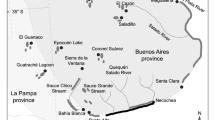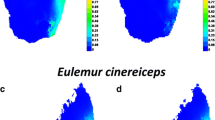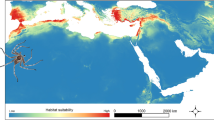Abstract
We modeled the geographical distribution of 4 pithecine primate species: brown-backed bearded sakis (Chiropotes israelita) and 3 black uakaris (Cacajao melanocephalus, C. hosomi, and C. ayresi) that inhabit remote regions of western Amazonas, Brazil. We applied a maximum entropy algorithm modeling program (MAXENT) to field data Boubli collected from 1991 to 2007. We used 23 environmental coverage variables to model the distribution of the primates. The layers were related to precipitation, temperature, topography, and ecological bioregions or Ecoregions. The predicted distribution for Cacajao hosomi was strongly associated with the Negro-Branco Moist Forest and Guianan Highlands Moist Forests Ecoregions, and the Worldclim variables Bio3 (isothermality), Bio4 (temperature seasonality) and Bio17 (precipitation of the driest quarter). Cacajao melanocephalus was strongly associated with Japurá/ Solimões-Negro Moist Forests, Caquetá Moist Forests, Purús Várzea Flooded Forests, Rio Negro Campinaranas, and Cordillera Oriental Montane Forests, Ecoregions. Cacajao ayresi was strongly associated with Negro-Branco Moist Forest and Rio Negro Campinarana Ecoregions as well as Worldclim Bio3 (isothermality). Chiropotes israelita was also strongly associated with Worldclim Bio3 (isothermality) followed by the Negro Branco Moist Forests and Guianan Piedmont and Lowland Moist Forests Ecoregion, and to the Guianan Highland moist forests. These results show a great overlap between the bearded saki and 2 black uakaris, Cacajao hosomi and C. ayresi. Given that one cannot attribute the separation between the species in the Rio Negro-Rio Branco interfluvium to the existence of geographical barriers such as rivers, we suggest that the present geographical boundaries and thus coexistence of the 3 pithecines north of the Rio Negro is maintained by competitive exclusion or stochastic events. Until more surveys are conducted, the present geographical distributions of the pithecines and the mechanism maintaining their boundaries in the Rio Negro-Rio Branco interfluvium will remain uncertain. One important contribution of our model is to identify areas of higher probability of occurrence that might be helpful in guiding future survey expeditions and choices of areas for future conservation of pithecines.




Similar content being viewed by others
References
Anderson, R. P., Gómez-Laverde, M., & Peterson, A. T. (2002). Geographical distributions of spiny pocket mice in South America: insights from predictive models. Global Ecology and Biogeography, 11, 131–141. doi:10.1046/j.1466-822X.2002.00275.x.
Ayres, J. M. (1989). Comparative feeding ecology of the uakari and bearded saki, Cacajao and Chiropotes. Journal of Human Evolution, 18, 697. doi:10.1016/0047-2484(89)90101-2.
Boinski, S. (1987). Habitat use by squirrel monkeys (Saimiri oerstedi) in Costa Rica. Folia Primatologica, 49, 151–167. doi:10.1159/000156319.
Bonvicino, C. R., Boubli, J. P., Otazu, I. B., Almeida, F. C., Nascimento, F. F., Coura, J. R., et al. (2003). Morphologic, Karyotypic and Molecular Evidence of a New Form of Chiropotes (Primates, Pitheciinae). American Journal of Primatology, 61, 123–133.
Boubli, J. P. (1997). A Study of the Black Uakari, Cacajao melanocephalus, in the Pico da Neblina National Park, Brazil. Neotropical Primates, 5(4), 113–115.
Boubli, J. P. (2002). Western Extention of the Range of Bearded Sakis: a Possible New Taxon of Chiropotes Sympatric with Cacajao in Pico da Neblina National Park, Brazil. Neotropical Primates, 10(1), 1–4.
Boubli, J. P., Silva, M. N. F., Amado, M. V., Herbk, T., Pontual, F. B., & Farias, I. (2008). A taxonomic reassessment of black uakari monkey, Cacajao melanocephalus, Humboldt (1811), with the description of two new species. International Journal of Primatology, 29, 723–741. doi:10.1007/s10764-008-9248-7.
Burgess, N. D., Loucks, C., Stolton, S., & Dudley, N. (2007). The potential of forest reserves for augmenting the protected area network in Africa. Oryx, 41, 151–159. doi:10.1017/S0030605307001895.
Cabeza, M., Araújo, M. B., Wilson, R. J., Thomas, C. D., Cowley, M. J. R., & Moilanen, A. (2004). Combining probabilities of occurrence with spatial reserve design. Journal of Applied Ecology, 41, 252–262. doi:doi:10.1111/j.0021-8901.2004.00905.x.
Colinvaux, P. A., De Oliveira, P. E., Moreno, J. E., Miller, M. C., & Bush, M. B. (1996). A long Pollen Record from Lowland Amazonia: Forest and Cooling in Glacial Times. Science, 274, 85–88.
Connell, J. H. (1978). Diversity in tropical rain forests and coral reefs. Science, 199, 1302. doi:10.1126/science.199.4335.1302.
Elith, J., Graham, C. H., Anderson, R. P., Dudik, M., Lohmann, L. G., Loiselle, B. A., et al. (2006). Novel methods improve prediction of species’ distribution from occurrence data. Ecography, 29, 129–151. doi:10.1111/j.2006.0906-7590.04596.x.
Graham, C. H., & Hijmans, R. J. (2006). A comparison of methods for mapping species ranges and species richness. Global Ecology and Biogeography, 15, 578–587. doi:10.1111/j.1466-8238.2006.00257.x.
Guisan, A., & Thuiller, W. (2005). Predicting species distribution: offering more than simple habitat models. Ecology Letters, 8, 993–1009. doi:10.1111/j.1461-0248.2005.00792.x.
Haugaasen, T., & Peres, C. A. (2005). Primate assemblage structure in Amazonian flooded and unflooded forests. American Journal of Primatology, 67, 243–258. doi:10.1002/ajp.20180.
Hernandez, P. A., Graham, C. H., Master, L. L., & Albert, D. L. (2006). The effect of sample size and species characteristics on performance of different species distribution modeling methods. Ecography, 29, 773–785. doi:10.1111/j.0906-7590.2006.04700.x.
Hijmans, R. J., & Graham, C. H. (2006). The ability of climate envelope models to predict the effect of climate change on species distributions. Global Change Biology, 12, 2272–2281. doi:10.1111/j.1365-2486.2006.01256.x.
Hijmans, R. J., Cameron, S. E., Parra, J. L., Jones, P., & Jarvis, A. (2005). Very high resolution interpolated climate surfaces for global land areas. International Journal of Climatology, 25, 1965–1978. doi:10.1002/joc.1276.
Hubbell, S. P. (2001). The Unified Neutral Theory of Biodiversity and Biogeography. Princeton, NJ: Princeton University Press.
Hutchinson, G. E. (1957). Concluding remarks. Cold Spring Harbor Symposia on Quantitative Biology, 22, 415–442.
Jepson, P., & Whittaker, R. J. (2002). Ecoregionsin context: a critique with special reference to Indonesia. Conservation Biology, 16, 42–57. doi:10.1046/j.1523-1739.2002.01143.x.
London, M., & Kelly, B. (2007). The Last Forest: The Amazon in the age of globalization. New York: Random House.
Olson, D. M. & Dinerstein, E. (2002). The Global 200: priority ecoregions for global conservation. Annals of the Missouri Botanical Garden, 89(2), 199–224.
Olson, D. M., Dinerstein, E., Wikramanayake, E. D., Burgess, N. D., Powell, G. V. N., Underwood, E. C., et al. (2001). Terrestrial ecoregions of the world: a new map of life on Earth. Bioscience, 51, 933–938. doi:10.1641/0006-3568(2001)051[0933:TEOTWA]2.0.CO;2.
Ortega-Huerta, M. A., & Peterson, A. T. (2004). Modelling spatial patterns of biodiversity for conservation prioritization in North-eastern Mexico. Diversity & Distributions, 10, 39–54. doi:10.1111/j.1472-4642.2004.00051.x.
Pearson, R. G., Raxworthy, C. J., Nakamura, M., & Peterson, A. T. (2007). Predicting species distributions from small number of occurrence records: a test case using cryptic geckos in Madagascar. Journal of Biogeography, 34, 102–117. doi:10.1111/j.1365-2699.2006.01594.x.
Peterson, A. T., Papes, M., & Eaton, M. (2007). Transferability and model evaluation in ecological niche modeling: a comparison of GARP and MAXENT. Ecograpghy, 30, 550–560.
Phillips, S. J., Dudik, M., & Schapire, R. E.(2004). A maximum entropy approach to species distribution modeling. In Proceedings of the 21st International Conference in Machine Learning (pp. 655–662). New York: ACM Press.
Phillips, S. J., Anderson, R. P., & Schapire, R. E. (2006). Maximum entropy modeling of species geographic distributions. Ecological Modelling, 190, 231–259. doi:10.1016/j.ecolmodel.2005.03.026.
Pulliam, H. R. (2000). On the relationship between niche and distribution. Ecology Letters, 3, 349–361. doi:10.1046/j.1461-0248.2000.00143.x.
Rapoport, E. (1982). Areography: Geographical strategies of species p. 269. Oxford: Pergamon Press.
Redford, K. H., Coppolillo, P., Sanderson, E. W., da Fonseca, G. A. B., Dinerstein, E., Grooves, C., et al. (2003). Mapping the conservation landscape. Conservation Biology, 17, 116–131. doi:10.1046/j.1523-1739.2003.01467.x.
Soberón, J., & Peterson, A. T. (2005). Interpretation of models of fundamental ecological niches and species’ distributional areas. Biodiversity Informatics, 1, 14–22.
Wallace, A. R. (1852). On the monkeys of the Amazon. Proceedings of the Zoological Society of London, 20, 107–110.
Wilson, K., Pressey, R. L., Newton, A., Burgman, M., Possingham, H., & Weston, C. (2005). Measuring and incorporating vulnerability into conservation planning. Environmental Management, 35, 527–543. doi:10.1007/s00267-004-0095-9.
Acknowledgments
We thank the Yanomami, the Catholic and evangelic missionaries, and the ribeirinho communities of Negro River Basin for their invaluable help during our surveys. We thank the Brazilian Army, FUNAI, and IBAMA for research permits and logistical support. The Sustainable Development of the Brazilian Biodiversity Program PROBIO/ MMA/BIRD/GEF/CNPq, the Zoological Society of San Diego, and the University of Auckland funded the surveys. IBAMA (license no. 005/2005 – CGFAU/LIC) granted permission to conduct fieldwork. M. G. de Lima thanks R. B. Machado for his help with the environmental data preparation.
Author information
Authors and Affiliations
Corresponding author
Rights and permissions
About this article
Cite this article
Boubli, J.P., de Lima, M.G. Modeling the Geographical Distribution and Fundamental Niches of Cacajao spp. and Chiropotes israelita in Northwestern Amazonia via a Maximum Entropy Algorithm. Int J Primatol 30, 217–228 (2009). https://doi.org/10.1007/s10764-009-9335-4
Received:
Accepted:
Published:
Issue Date:
DOI: https://doi.org/10.1007/s10764-009-9335-4




